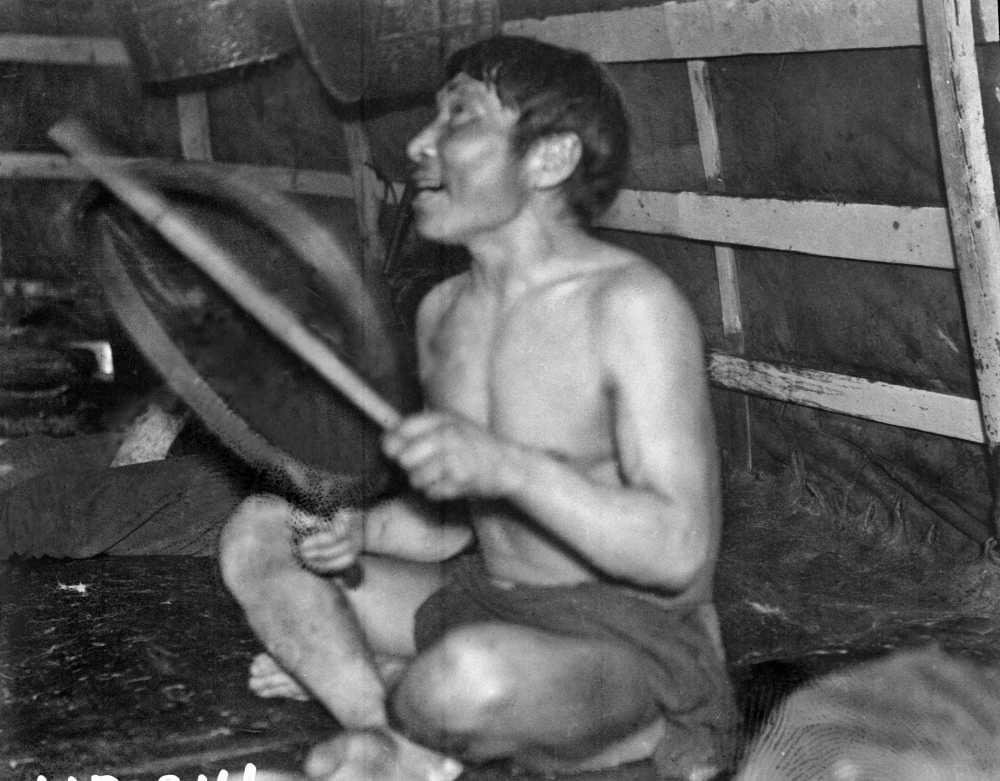Spiritual culture
Traditional beliefs of Asian Inuits are close to those of the Chukchi. Shamanism is widespread. Inuits traditionally saw a shaman, who could be either a man or a woman, as an intermediary between spirits and people. He treated diseases, found people lost in the tundra, influenced the weather, and “summoned” spirits. Inuit shamans did not wear special clothes, but they did wear such accessories as pendants, fringes, and tassels.
Shamanic ritual. Asian Inuits. Chukotka autonomous area, Provideniya District (village of Ungazik), Providence Bay. 1927–1929. Alexander S. Forshtein’s collection. 5.3х8 sm Anthropology and Ethnography Museum. I 115-20
Inuits believed in three main deities: Sedna, the lady of the sea, Kiygnyk, the lord of the air and universe, and Pinga, the lady of the land. Inuits also believed in an impersonal power (
khila
) that natural phenomena and people’s luck depended on.
Inuits believed each world to be populated by evil and good spirits. Good spirits were associated with animals and birds, and evil spirits were imagined as anthropomorphic giants or dwarfs, or as creatures of the most fantastic shapes. The underworld spirit Nunamyo was considered to be the cruelest of all. All spirits had to be placated with sacrifices.
Inuits believed the earthly world to be population by a host of master spirits,
inua
. They believed, for instance, air, wind, water, land, plants, mountains, ice, hills, stones, sleep, etc. to have their own
inua
. Success in economic activities depended on the
inua
. Only shamans communicated with the
inua
, although during a hunt, an Inuit could themself call on their helping spirit to ensure the spirit’s support, or could sing a special song to lure game.
Killing an animal was not considered murder. Inuits believed that animals wanted to be killed because their spirits came back to gain flesh. But animals want their death to be accompanied by proper rituals: the killed animal had to be appeased so that it would always come to people. So, a hunter would never bring their kill into the house. His wife had first to come out and give the killed animal water to drink from a special ritual bowl. After sea hunting, Inuits gave gifts to the lord of the sea.
Most Inuit holidays were tied to hunting worship and were celebrated in the fall, winter, and spring. Holidays included a sacrifice, dances, songs, games, gift giving, and sharing a meal. The most famous were the whale holiday, the walrus head holiday, the bidar launch holiday, and the young hunter holiday.
The Inuits traditionally held funerals rites the day after one’s death. The deceased was dressed in white funeral clothing. The dead person was lashed with leather thongs to one or two wooden poles that had leather loops attached at the front and at the back to carry the body; the dead person’s face was covered with reindeer pelt or hood so that their spirit would not see the way and would not come back. Before carrying the body out, the relatives had a meal.
Most frequently, Asian Inuits buried their dead in screes. A shallow depression in the stones served as a grave. Before, the body of the dead would be left in the snow since digging a grave in frozen ground was impossible. Large stone were left around the dead in an open burial, and the dead person’s deliberately ruined personal effects were left around the grave. Their clothes would be cut into bits, the sled used to transport the body would be broken into pieces; all those parts were piled around the body and pressed with stones. The wooden pole the dead body had been lashed to would be left at the dead person’s feet. The dead person’s personal effects intended to be “taken on the journey” were put closer to their head. Men would be given a knife, a rifle, a harpoon, a pipe, tobacco, and tools, while women received needles, a knife, and a wooden platter. On the way back, the people did not go straight home and walked along the sea coast for a while.























































